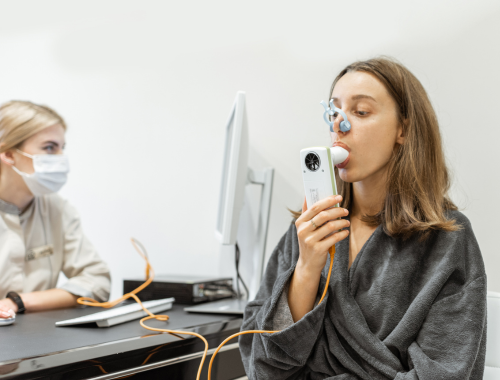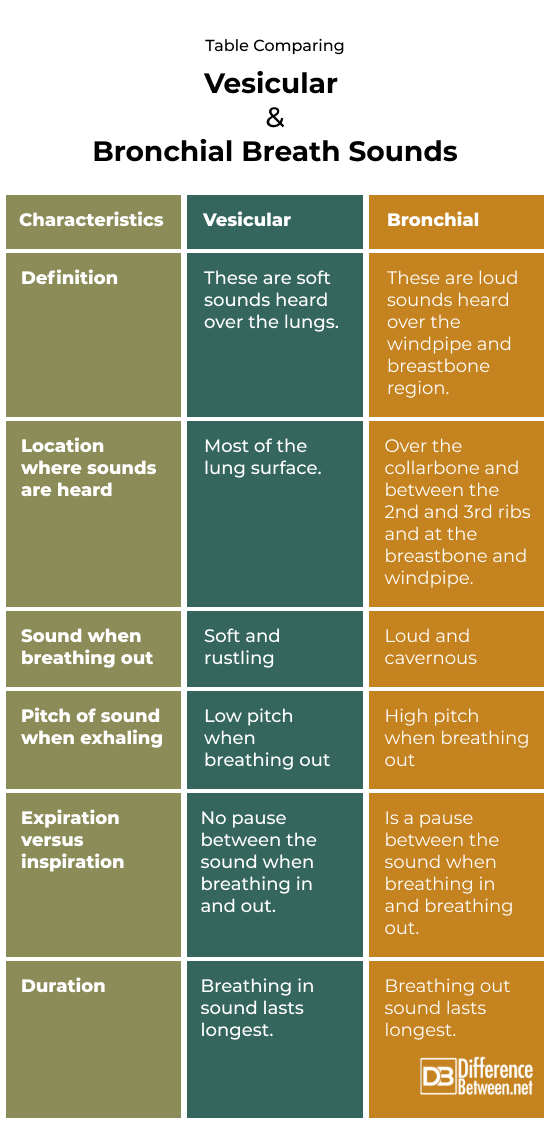Difference Between Vesicular and Bronchial Breath Sounds
Vesicular breath sounds are soft, rustling sounds heard over the lungs. Bronchial breath sounds are loud sounds heard high up over the breastbone.

What are Vesicular breath sounds?
Definition:
Vesicular breath sounds are rustling sounds a doctor hears when listening to the chest with a stethoscope.
Location and properties:
The vesicular breath sounds are usually heard over the entire lung area. These sounds are soft, low-pitched and are heard continuously through all of the inhalation (inspiration) process and most of the exhalation (expiration).
Pathological changes:
Changes can occur in the vesicular sounds if the person is ill. For instance, crackles may be heard if the person has pneumonia. Wheezing may also be heard if the person has COPD or asthma. Interruption heard when the person is breathing in, may signal an obstruction such as an aneurysm in the aorta or swollen lymph glands in the middle of the chest.

What are Bronchial breath sounds?
Definition:
These are sounds that are heard in healthy individuals when listening over the trachea.
Location and properties:
The bronchial breath sounds occur when the doctor listens over the windpipe and breastbone by the 2nd and 3rd ribs. These sounds are louder when compared with vesicular breath sounds. Bronchial breath sounds are also described as cavernous and loud. They are also higher-pitched than vesicular sounds.
Pathological changes:
If bronchial sounds are heard elsewhere in the respiratory system such as over the lungs, then illness is likely. The sounds may then indicate conditions such as atelectasis (collapse of some section of the lung), lung tumors, or pneumothorax (air accumulates between the lung and pleural membranes of the lung).
Difference between Vesicular and Bronchial breath sounds?
Definition
Vesicular breath sounds are soft sounds that are heard over the lungs. Bronchial breath sounds are loud sounds heard over the windpipe region.
Location where sounds are heard
Vesicular breath sounds are heard over most of the lung surface. Bronchial breath sounds occur over the collarbone and between the 2nd and 3rd ribs and at the breastbone and over the trachea.
Sound when breathing out
A soft, rustling sound is head on expiration with vesicular breath sounds. A loud, sometimes cavernous sound is head on expiration with bronchial breath sounds.
Pitch of sound when exhaling
In the case of vesicular breath sounds, there is a low-pitched sound on exhalation. In the case of bronchial breath sounds, there is a high-pitched sound on exhalation.
Expiration versus inspiration
With vesicular breath sounds, the sounds are heard continuously from inspiration to expiration without a pause in between. With bronchial breath sounds there is a pause between hearing the sounds of inspiration and expiration.
Duration
In the case of vesicular breath sounds, the sounds of breathing in are of longer duration than those of breathing out. In the case of bronchial breath sounds, the sounds of breathing out are of longer duration than those of breathing in.
Table comparing Vesicular and Bronchial breath sounds

Summary of Vesicular Vs. Bronchial breath sounds
- Vesicular and bronchial breath sounds can be heard in healthy people.
- Vesicular sounds are soft while bronchial sounds are loud.
- Variations in the sounds and where specific breath sounds are heard may indicate that a person has an illness.
FAQ
What is the difference between normal and bronchial breath sounds?
Normal breath sounds include bronchial sounds that a doctor ca hear over the breastbone and vesicular sounds are the sounds that the doctor can hear over the lungs.
What do bronchial breath sounds indicate?
Bronchial breath sounds may indicate a healthy person but they may also indicate illness, only a visit to a doctor can confirm if you are healthy or not. It depends where the doctor can hear the bronchial sounds during the process of listening to the chest through the stethoscope. If bronchial sounds are heard over the lungs and low down, then it may indicate that the person is unwell and has a pathological condition.
What may be heard in vesicular breath sounds?
A soft, low-pitched rustling sound is heard with vesicular breath sounds. The sounds are also heard both during inspiration and expiration by the doctor listening with a stethoscope.
What are types of breath sounds and how do you differentiate them?
There are several types of breath sounds including vesicular, bronchial, rales, wheezing, crackles, and stridor. The last four are pathological sounds. Breath sounds can be differentiated based on where they are heard and the pitch and type of sound that is heard. For instance, crackles are when a crackling sound is heard in the lungs.
Where are vesicular breath sounds best heard?
These sounds are heard most clearly over the bottom part of the lungs and beneath where the second rib is located.
How do you assess bronchial breath sounds?
You use the stethoscope and start by listening near the top of the breastbone and move downwards, and then also listen on the back moving downwards from top to bottom. An entire respiratory cycle needs to be heard in each case to properly assess the patient.
- Difference Between Rumination and Regurgitation - June 13, 2024
- Difference Between Pyelectasis and Hydronephrosis - June 4, 2024
- Difference Between Cellulitis and Erysipelas - June 1, 2024
Search DifferenceBetween.net :
Leave a Response
References :
[0]Dezube, Rebecca. “Evaluation of the Pulmonary Patient”. Merckmanuals. Merck & Co., 2022, https://www.msdmanuals.com/professional/pulmonary-disorders/approach-to-the-pulmonary-patient/evaluation-of-the-pulmonary-patient
[1]Nagasaka, Yukio. "Lung sounds in bronchial asthma." Allergology International 61.3 (2012): 353-363.
[2]Sarkar, Malay, et al. "Auscultation of the respiratory system." Annals of thoracic medicine 10.3 (2015): 158.
[3]Image credit: https://www.canva.com/photos/MAEMmT4yT5s-young-woman-during-a-spirometry-test/
[4]Image credit: https://www.canva.com/photos/MAEYKnXdL3Q-senior-man-testing-breathing-function-by-spirometry/
